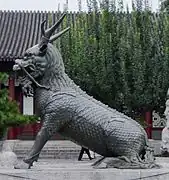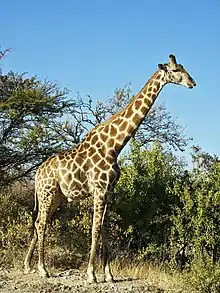麒麟
Chinese
| male unicorn | female unicorn | ||
|---|---|---|---|
| trad. (麒麟) | 麒 | 麟 | |
| simp. #(麒麟) | 麒 | 麟 | |
| alternative forms | 騏驎 obsolete 麒麐/麒麟 obsolete | ||

Etymology
Qilin was a propitious beast in ancient Chinese mythology, with the shape of a deer, tail of an ox, a single horn and scales all over its body. Old Chinese pronunciation for this word was *g(ɯ)-rin (Zhengzhang), and in pre-Qin times the beast was also referred to as
- 麟 (OC *rin),
- 麐 (OC *m·rin, *m·rins),
- 𪊓, or
- 蔽 (OC *peds),
the last two having been attested in the oracle bone script already. This is much debate as to what animal the qilin beast was; some maintain that the qilin was a beast only found in mythology, even though it may have been based on some animal in pre-historic times, and some argue that the qilin was in reality the river deer, the ox or cow, or the Indian rhinoceros (Wang, 2009).
During the Song–Ming Dynasties, the giraffe was introduced to China, either by envoys from other Asian or African countries, or through Zheng He who commanded multiple expeditionary voyages to Asia and Africa (Zhang, 2007). Besides using the transcription 祖剌法 (zǔlàfǎ) (from Arabic زُرَافَة (zurāfa, “giraffe”)) to name the animal, the Chinese also referred to it as qilin, believing it was the prototype of the mythological beast qilin. Such association may be due to the phonological similarity of the words for “giraffe” in North African languages, to the pronunciation of 麒麟 at the time (i.e. a phono-semantic matching) (Zhang, 2007). Compare:
- Somali geri (“giraffe”), Sango kôlo, Amharic ቀጭኔ (ḳäč̣ne), Kazakh керік (kerık), Mursi kirin[1] and Arabic زَرَافَة (zarāfa), زُرَافَة (zurāfa) (whence English giraffe).
The “giraffe” sense of 麒麟 is obsolete in most varieties of modern Chinese, but is preserved in the Sinoxenic loanwords in Japanese (麒麟 (kirin)) and Korean (기린). In modern Vietnamese (kì lân), this word refers to the beast qilin, as well as the western mythological beast unicorn.
Janhunen (2011) tentatively compares 麒麟 (OC *ɡɯ rin) to a Northeast Asian etymon *kalimV, which denotes either "whale" or "mammoth"; however, he cautiously remarks that "[t]he formal and semantic similarity between *kilin < *gilin ~ *gïlin 'unicorn' and *kalimV 'whale' (but also Samoyedic *kalay- 'mammoth') is sufficient to support, though perhaps not confirm, the hypothesis of an etymological connection". He also notes a possible connection between Old Chinese and Mongolian (*)kers ~ (*)keris ~ (*)kiris "rhinoceros" (> Khalkha Mongolian хирс (xirs)).
Pronunciation
Noun
麒麟
- (Chinese mythology) qilin (propitious mythological beast) (Classifier: 隻/只 m c mn)
- 豈惟民哉?麒麟之於走獸,鳳凰之於飛鳥,太山之於丘垤,河海之於行潦,類也。 [Classical Chinese, trad.]
- From: Mencius, c. 4th century BCE
- Qǐ wéi mín zāi? Qílín zhī yú zǒushòu, fènghuáng zhī yú fēiniǎo, Tàishān zhī yú qiūdié, hé hǎi zhī yú xíngliáo, lèi yě. [Pinyin]
- Is it only among men that it is so? There is the Qilin among quadrupeds, the Fenghuang (phoenix) among birds, the Tai mountain among mounds and ant-hills, and rivers and seas among rain-pools. Though different in degree, they are the same in kind.
岂惟民哉?麒麟之于走兽,凤凰之于飞鸟,太山之于丘垤,河海之于行潦,类也。 [Classical Chinese, simp.]
- (figurative, literary) outstanding person; man of ability
- (literary or Taiwanese Hokkien) giraffe (ruminant of the genus Giraffa) (Classifier: 隻/只 mn)
Synonyms
- (outstanding person):
|
|
- (giraffe):
| Variety | Location | Words edit |
|---|---|---|
| Formal (Written Standard Chinese) | 長頸鹿 | |
| Taxonomic name | 長頸鹿 | |
| Mandarin | Beijing | 長脖兒鹿 |
| Taiwan | 長頸鹿 | |
| Ürümqi | 長脖兒鹿 | |
| Liuzhou | 長頸鹿 | |
| Singapore | 長頸鹿 | |
| Cantonese | Hong Kong | 長頸鹿 |
| Hakka | Miaoli (N. Sixian) | 長頸鹿 |
| Pingtung (Neipu; S. Sixian) | 長頸鹿 | |
| Hsinchu County (Zhudong; Hailu) | 長頸鹿 | |
| Taichung (Dongshi; Dabu) | 長頸鹿 | |
| Hsinchu County (Qionglin; Raoping) | 長頸鹿 | |
| Yunlin (Lunbei; Zhao'an) | 長頸鹿 | |
| Min Nan | Xiamen | 長頸鹿, 長頷鹿 |
| Taipei (Wanhua) | 長頭鹿 | |
| New Taipei (Tamsui) | 長頭鹿 | |
| Kaohsiung | 麒麟仔 | |
| Kaohsiung (Cijin) | 長頷頸 | |
| Kaohsiung (Dalinpu, Siaogang) | 長鹿仔 | |
| Yilan | 長頷鹿 | |
| Yilan (Toucheng) | 躼跤鹿仔 | |
| Changhua (Lukang) | 麒麟鹿 | |
| Taichung | 麒麟 | |
| Taichung (Wuqi) | 麒麟鹿 | |
| Tainan | 長頷鹿 | |
| Taitung | 長頷鹿 | |
| Hsinchu | 長頷鹿 | |
| Penghu (Magong) | 長頷鹿 | |
| Penang (Hokkien) | 麒麟鹿, 長頸鹿 | |
| Singapore (Hokkien) | 麒麟鹿, 長跤鹿, 長頸鹿 | |
Derived terms
|
|
Descendants
- → Japanese: 麒麟 (kirin)
- → Korean: 기린(麒麟) (girin)
- → Vietnamese: kì lân (麒麟)
Others:
- → Thai: กิเลน (gì-leen)
- → Zhuang: geizlaenz, gizlinz
Proper noun
麒麟
- (~區) Qilin District (district in Qujing, Yunnan province, China)
- (~鎮) Qilin (a town in Zongyang, Tongling, Anhui, China)
References
- David Turton, Mozes Yigezu, Oilsarali Olibui, Mursi-English-Amharic Dictionary, 2009
Japanese
| Kanji in this term | |
|---|---|
| 麒 | 麟 |
| き Jinmeiyō | りん Jinmeiyō |
| kan’on | on’yomi |
| Alternative spellings |
|---|
| 騏驎 (general use) キリン (giraffe, beer) |
 麒麟 (kirin): a statue of a qilin, also known as the Chinese unicorn.
麒麟 (kirin): a statue of a qilin, also known as the Chinese unicorn. 麒麟 (kirin): a giraffe.
麒麟 (kirin): a giraffe.
Etymology
From Old Japanese, in turn from Middle Chinese 麒麟 (MC ɡɨ liɪn). First cited in Japanese to the Nihon Shoki of 720.[1]
The giraffe sense was probably based on a superficial resemblance between certain depictions of the mythical beast and the patterning and body shape of the real animal: a tailed, hoofed, and horned quadruped with a vaguely leopard-like spot pattern. First cited in Japanese to a text from 1798.[1]
Pronunciation
- (Tokyo) きりん [kìríń] (Heiban – [0])[2][3][4]
- IPA(key): [kʲiɾʲĩɴ]
Noun
麒麟 • (kirin)
- [from 720] 麒麟, 騏驎: (mythology, Chinese mythology) a qilin
- 2010 May 23, Aoyama, Gosho, “FILE.5 青龍 [FILE 5: Azure Dragon]”, in 名探偵コナン [Legendary Detective Conan], volume 68 (fiction), Tokyo: Shogakukan, →ISBN:
- それは動物のキリン!問題の麒麟は…全身が黄色い鱗で覆われていて、姿は鹿、牛の尾と馬の蹄を持ち、龍に似た頭から1本角が生えてる…中国の伝説上の神獣だよ!
- Sore wa dōbutsu no kirin! Mondai no kirin wa… Zenshin ga kiiroi uroko de ōwarete ite, sugata wa shika, ushi no o to uma no hizume o mochi, ryū ni nita atama kara ippon tsuno ga haete ru… Chūgoku no densetsu jō no shinjū da yo!
- That’s giraffe the animal! The qilin we’re talking about… has a deer-like body covered in golden scales, with a cow’s tail and a horse’s hooves, and with a single horn growing from its dragonish head… It’s a mythical beast from Chinese legends!
- それは動物のキリン!問題の麒麟は…全身が黄色い鱗で覆われていて、姿は鹿、牛の尾と馬の蹄を持ち、龍に似た頭から1本角が生えてる…中国の伝説上の神獣だよ!
-
- [date unknown] 麒麟, 騏驎: (shogi) the kirin, a piece in chūshōgi and larger shogi variants
- [from 1798] 麒麟, 騏驎, キリン: a giraffe (mammal)
- Synonym: ジラフ (jirafu)
- 2010 May 23, Aoyama, Gosho, “FILE.5 青龍 [FILE 5: Azure Dragon]”, in 名探偵コナン [Legendary Detective Conan], volume 68 (fiction), Tokyo: Shogakukan, →ISBN:
- それは動物のキリン!問題の麒麟は…全身が黄色い鱗で覆われていて、姿は鹿、牛の尾と馬の蹄を持ち、龍に似た頭から1本角が生えてる…中国の伝説上の神獣だよ!
- Sore wa dōbutsu no kirin! Mondai no kirin wa… Zenshin ga kiiroi uroko de ōwarete ite, sugata wa shika, ushi no o to uma no hizume o mochi, ryū ni nita atama kara ippon tsuno ga haete ru… Chūgoku no densetsu jō no shinjū da yo!
- That’s giraffe the animal! The qilin we’re talking about… has a deer-like body covered in golden scales, with a cow’s tail and a horse’s hooves, and with a single horn growing from its dragonish head… It’s a mythical beast from Chinese legends!
- それは動物のキリン!問題の麒麟は…全身が黄色い鱗で覆われていて、姿は鹿、牛の尾と馬の蹄を持ち、龍に似た頭から1本角が生えてる…中国の伝説上の神獣だよ!
Usage notes
As with many terms that name organisms, this term is often spelled in katakana, especially in biological contexts (where katakana is customary), as キリン.
Derived terms
- 麒麟角 (kirinkaku)
- 麒麟閣 (KirinKaku)
- 麒麟菊 (kiringiku)
- 麒麟竭 (kirinketsu)
- 麒麟座 (Kirin-za, “Camelopardalis”)
- 麒麟菜 (kirinsai)
- 麒麟児 (kirinji, “rising star”)
- 麒麟草 (kirinsō)
- 麒麟欄 (kirinran)
- 麒麟羚羊 (kirin reiyō, “gerenuk”)
See also
 麒麟 (mythology) on the Japanese Wikipedia.Wikipedia ja
麒麟 (mythology) on the Japanese Wikipedia.Wikipedia ja Qilin on Wikipedia.Wikipedia
Qilin on Wikipedia.Wikipedia  キリン (giraffe) on the Japanese Wikipedia.Wikipedia ja
キリン (giraffe) on the Japanese Wikipedia.Wikipedia ja Giraffe on Wikipedia.Wikipedia
Giraffe on Wikipedia.Wikipedia
References
- “麒麟・騏驎”, in 日本国語大辞典 (Nihon Kokugo Daijiten, “Nihon Kokugo Daijiten”) (in Japanese), 2nd edition, Tōkyō: Shogakukan, 2000, →ISBN
- 2006, 大辞林 (Daijirin), Third Edition (in Japanese), Tōkyō: Sanseidō, →ISBN
- 1998, NHK日本語発音アクセント辞典 (NHK Japanese Pronunciation Accent Dictionary) (in Japanese), Tōkyō: NHK, →ISBN
- 1997, 新明解国語辞典 (Shin Meikai Kokugo Jiten), Fifth Edition (in Japanese), Tōkyō: Sanseidō, →ISBN
Korean
| Hanja in this term | |
|---|---|
| 麒 | 麟 |
Noun
麒麟 • (girin or McCune-Reischauer: kirin or Yale: kilin) (hangeul 기린)
- Hanja form? of 기린 (“giraffe; qilin”).
Vietnamese
| Hán tự in this term | |
|---|---|
| 麒 | 麟 |
Noun
麒麟
- chữ Hán form of kì lân (“qilin”).